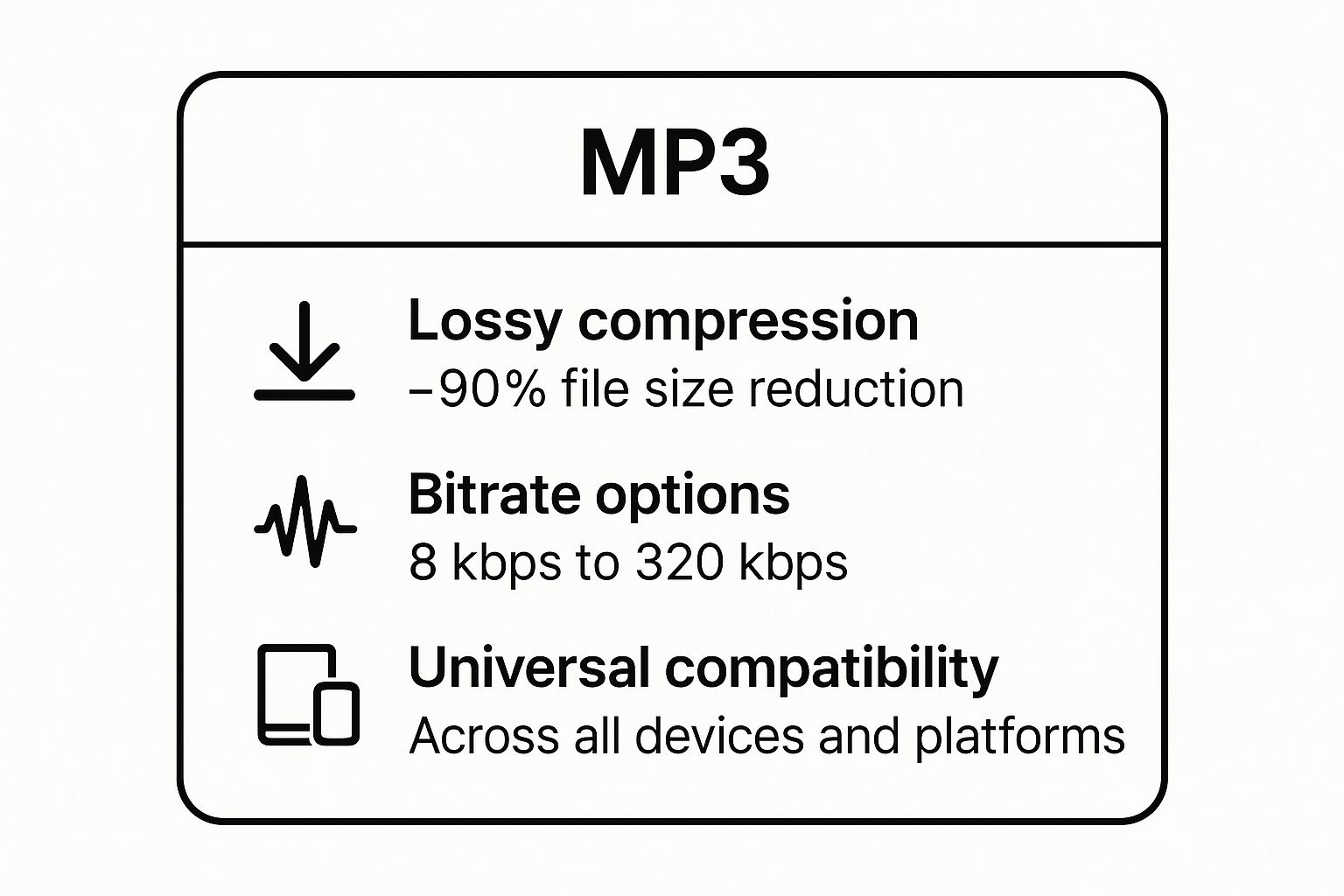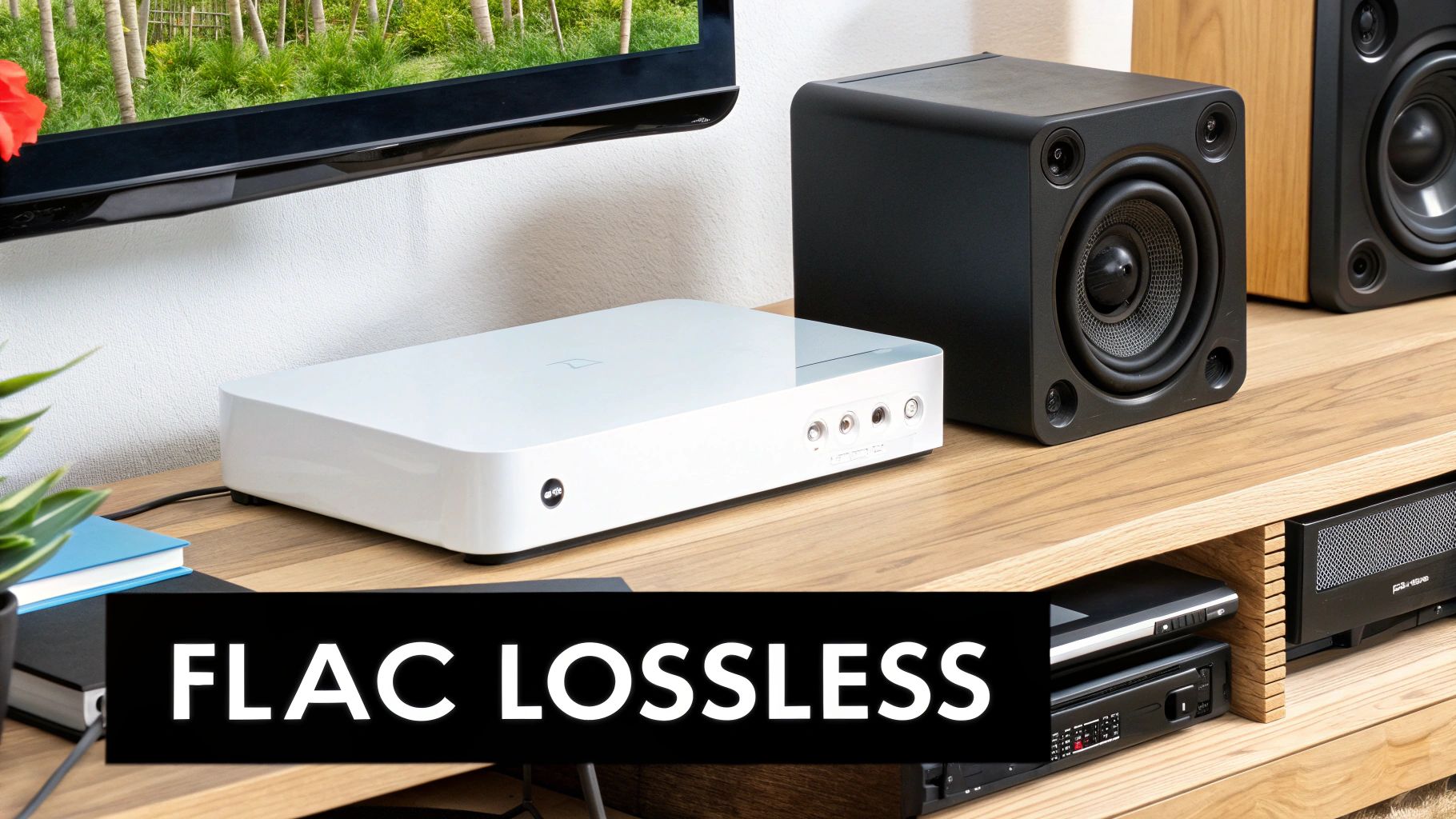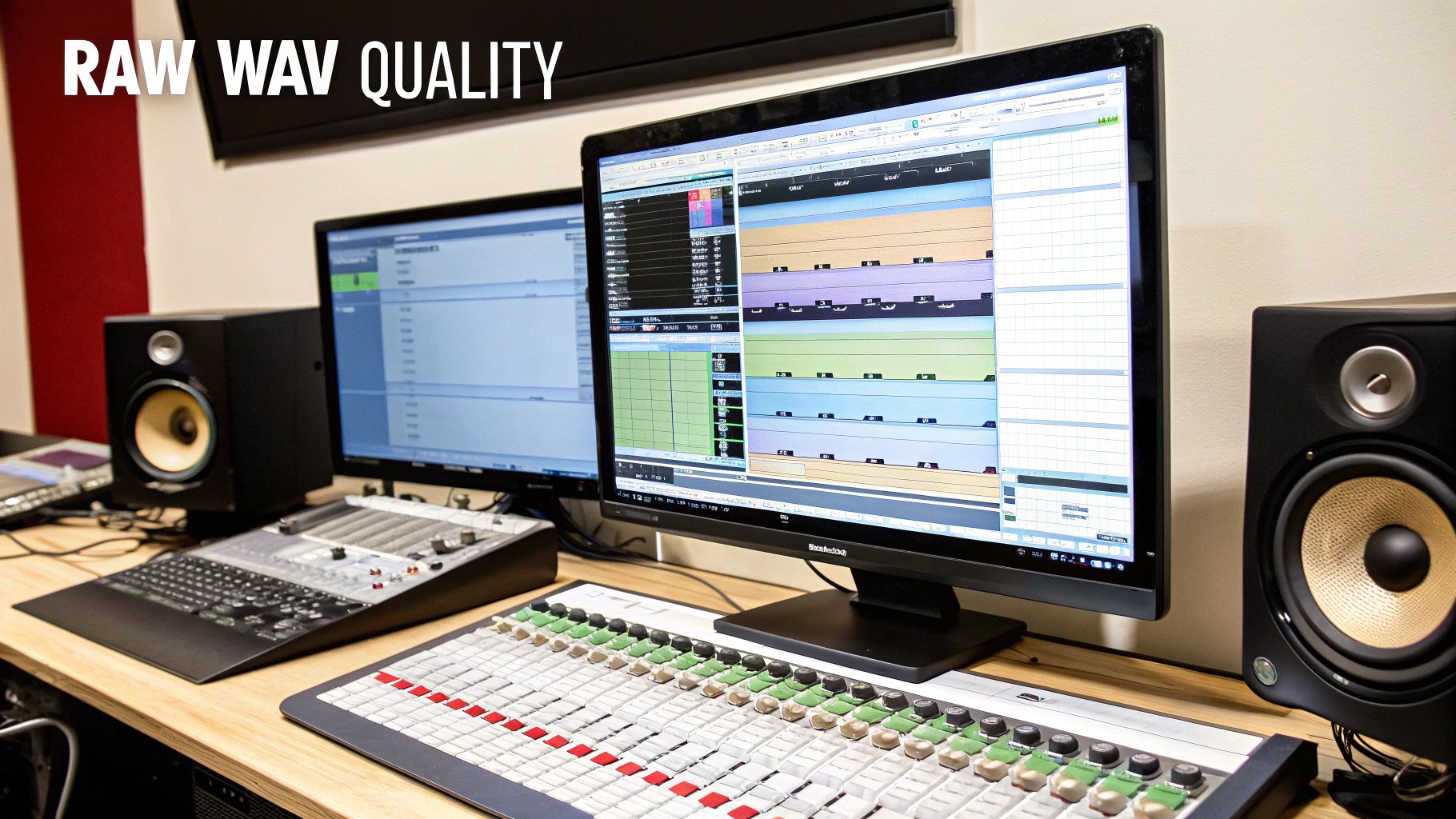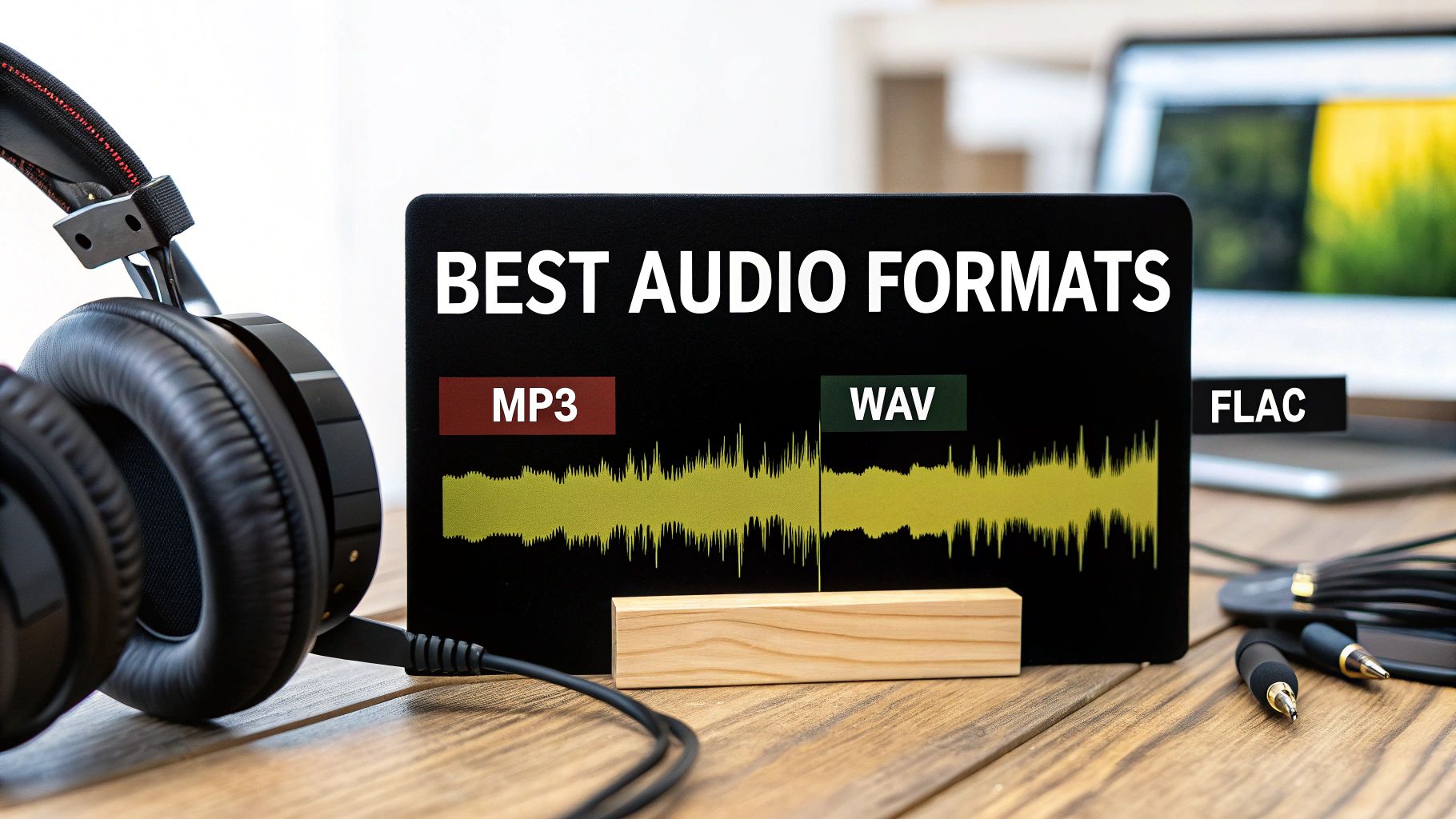Picking the right audio format can feel like a chore, but trust me, getting it right can make or break your project’s quality, file size, and compatibility. In this guide, I’ll personally walk you through the best audio file formats so you know exactly when to use each one.
Here’s what you’ll get:
- Detailed specs for each format
- Pros and cons based on real-world scenarios
- My recommended use-cases with practical tips
We’ll cover everything from streaming podcast episodes in AAC to archiving your precious studio masters in FLAC. I'll also share some quick tips on encoding settings, bit rate recommendations, and how I use HeftySend for seamless file transfers.
No more guesswork about MP3 vs FLAC or WAV vs AAC. Whether you’re a freelance designer, running a podcast studio, or a busy media agency, choosing the right format saves you time and protects your sound.
Picking the optimal format also impacts storage costs and download speeds—crucial details when you’re sending files to clients. By the end of this, you’ll be able to pick a format that perfectly balances fidelity, file size, and compatibility for any workflow.
And when you’re ready to share those large files without a headache, HeftySend has your back. I built it for creatives like us—transfer up to 20 GB for free with instant browser previews and no bandwidth limits. Let’s dive in and find your perfect audio format.
1. MP3 (MPEG-1 Audio Layer III)
The MP3 is probably the most famous audio format in the world, and for good reason. It kicked off the digital audio revolution, making it possible to store and share music efficiently without needing a server farm for storage. Its place as one of the best audio file formats is secured by its history and near-universal compatibility.
MP3 works through a clever process of lossy compression. Using what are called psychoacoustic models, it analyzes the audio and throws away data the human ear is least likely to notice—like sounds that are too high, too low, or masked by louder ones. This trick can shrink file sizes by up to 90% compared to uncompressed formats like WAV, making it incredibly practical for streaming and sharing.
When to Use MP3
MP3 is my go-to format for consumer-grade audio distribution. Its small file size and universal device support make it ideal for:
- Podcasts and Audiobooks: Where file size is more critical than pristine, studio-quality sound.
- Streaming Services: Many platforms, like Spotify, still use MP3 (or its close relative, Ogg Vorbis) for their standard quality streams to ensure smooth playback, even on a shaky internet connection.
- General Music Listening: For everyday use on your smartphone, car stereo, or portable player, a high-bitrate MP3 is often indistinguishable from a lossless file for most people.
The infographic below gives you a quick reference on the core strengths of the MP3 format, highlighting its compression efficiency, bitrate flexibility, and widespread support.

As you can see, the format’s strength is its balance of size, quality, and universal adoption. This makes it a reliable choice for final delivery files, especially when you need to send audio previews to clients. Sharing a folder of MP3s is simple and fast with a service like HeftySend, ensuring your recipients can open and play the files on any device without hassle. Just a word of caution: try not to re-encode an MP3, as each compression cycle will degrade the quality a little more.
2. FLAC (Free Lossless Audio Codec)
FLAC is an open-source lossless compression format that reduces file sizes by 30–60% without any quality loss. It’s become the gold standard for audiophiles and music archiving because it offers a perfect reconstruction of the original audio. As one of the best audio file formats, FLAC perfectly balances storage efficiency with studio-grade fidelity.

So, how does it work? FLAC applies clever algorithms to each audio frame, preserving every single sample without tossing any data. Compression levels range from 1 (fastest, smallest reduction) to 8 (slowest, biggest reduction), letting you choose the best trade-off between encoding time and file size. This method guarantees bit-perfect playback on any compatible device.
When to Use FLAC
- Archiving CD Collections:
I usually choose compression level 5–8 for a 40–50% file size cut while keeping every detail intact. - High-Resolution Streaming:
Platforms like Tidal HiFi and HDtracks use FLAC to deliver studio-quality audio to your ears. - Professional Mastering:
It's perfect for sharing final mixes and stems with collaborators, ensuring bit-exact transfers in your DAW. - Audiophile Listening:
Pair FLAC files with a good DAC and headphones to hear every tiny nuance in the music.
As a go-to among the best audio file formats, FLAC is perfect for archiving, professional workflows, and your personal lossless library. When you need to send large FLAC folders to clients or collaborators, use a service like HeftySend. Simply upload your files at HeftySend.com and get a shareable link—recipients can download full-resolution audio on any device without format hassles. It’s exactly why we built it.
3. WAV (Waveform Audio File Format)
The WAV is the absolute gold standard for uncompressed audio, developed by Microsoft and IBM to store raw sound data exactly as it was recorded. It delivers perfect fidelity with zero loss from compression, which is why professionals like me rely on it for editing, mixing, and archiving. The trade-off is massive file sizes, but for master recordings, you simply can’t beat its clarity.

WAV works by wrapping raw audio samples—often at 16-bit/44.1 kHz or even higher—in a simple container. There’s no lossy compression, so every nuance of the performance remains intact. Most DAWs default to WAV because it’s universally supported and can be edited without decoding or losing quality. You can even step up to 24-bit/96 kHz for extra headroom in professional mixes.
When to Use WAV
- Professional recording and editing: Capture the full dynamic range in the studio.
- CD production: It's the standard for 16-bit/44.1 kHz masters.
- High-end mixing and mastering: Preserve audio quality through multiple processing stages.
- Sound libraries and samples: Archive your raw takes without any risk of artifacts.
- Broadcast workflows: The WAV-BWF extension embeds timecodes and other crucial metadata.
In my experience, keeping a lossless WAV master is essential before exporting compressed files for delivery. When it’s time to share those hefty session files with clients, I turn to HeftySend.com. Sending dozens of gigabytes of WAV tracks is no problem—recipients get smooth, secure downloads without any fuss. Just remember to convert to smaller formats like MP3 or AAC for final delivery if your client is concerned about storage or bandwidth.
4. AAC (Advanced Audio Coding)
Often seen as the direct successor to MP3, AAC (Advanced Audio Coding) delivers superior sound quality at the same bitrate. This format represents a more modern approach to audio compression, earning its spot among the best audio file formats due to its incredible efficiency and widespread use in today's digital world.
AAC improves on the MP3 model by using more advanced lossy compression algorithms. This results in a more faithful audio representation, which is especially noticeable in complex music with lots of detail. In a side-by-side comparison, a 256 kbps AAC file often sounds as good as, or even better than, a 320 kbps MP3, all while taking up less space.
When to Use AAC
AAC is the undisputed king of the Apple ecosystem and a top choice for modern streaming, making it perfect for:
- Apple Devices: It’s the standard format for iTunes, Apple Music, iPhones, and iPads, ensuring seamless playback and optimized performance.
- Online Streaming: Major platforms like YouTube use AAC for their audio streams because it provides excellent quality for a given bandwidth.
- Broadcasting and Gaming: Digital TV and consoles like the PlayStation and Xbox often use AAC for its efficient, high-quality audio compression.
Its superior efficiency makes it an excellent choice for creating high-quality, manageable files for mobile listening or streaming previews. When I need to send audio to a client who primarily uses Apple devices, exporting to AAC is a smart move. Using HeftySend to transfer these files ensures my client gets a manageable, high-quality preview they can open natively without any extra steps.
5. OGG Vorbis
OGG Vorbis stands out as a free, open-source, and patent-unencumbered audio format, which definitely earns it a solid place among the best audio file formats. Developed by the Xiph.Org Foundation, it was created as a high-quality alternative to proprietary formats like MP3 and AAC. I love its philosophy: providing superior audio fidelity without the legal and financial headaches of patents.
The format uses a sophisticated form of lossy compression that is often considered more efficient than MP3 at similar bitrates. OGG Vorbis is great at preserving more of the original audio's nuance, particularly in the mid and high-frequency ranges. This results in a cleaner, more detailed sound that many developers and audiophiles prefer.
When to Use OGG Vorbis
OGG Vorbis is the ideal choice for projects where open-source principles and high-quality compression are priorities. I find it’s particularly well-suited for:
- Web Applications and Streaming: Its efficiency makes it perfect for web-based audio. Spotify famously uses OGG Vorbis for its desktop and web player streams.
- Video Game Development: Developers often use OGG for in-game music and sound effects to save space and avoid licensing fees.
- Open-Source Projects: The free and open nature of OGG makes it a natural fit for platforms built on open-source tech, like Wikipedia.
The video below provides a deeper dive into what makes the OGG container and Vorbis codec so unique and effective for modern audio needs.
While OGG is widely supported in software players like VLC and in browsers, it lacks the universal hardware support of MP3. However, when you need to share high-quality audio files for a game or web project, its advantages are clear. Bundling your OGG assets into a single transfer with HeftySend ensures your team gets all the files they need in one organized, easy-to-download package.
6. AIFF (Audio Interchange File Format)
AIFF is an uncompressed audio format developed by Apple back in 1988, serving as its answer to Microsoft's WAV format. As a professional-grade format, it stores audio in a lossless, uncompressed state, preserving every single detail of the original recording. Its position as one of the best audio file formats is cemented by its widespread use in professional Mac-based production environments.
Like its rival WAV, AIFF is uncompressed and lossless, meaning it offers a bit-for-bit perfect copy of the source audio. This makes it a standard for recording, mixing, and mastering. Where AIFF historically stood out was its superior support for metadata, allowing for more detailed information like album art and track names to be embedded right into the file.
When to Use AIFF
AIFF is the undisputed choice for audio professionals working within the Apple ecosystem. Its uncompressed nature and native macOS integration make it ideal for:
- Music Production and Mastering: In apps like Apple's Logic Pro X, AIFF is the default format for recording and bouncing audio, ensuring maximum fidelity.
- Professional Audio Editing: For any critical editing or sound design work on a Mac, AIFF provides the raw, unaltered audio data you need for precise manipulation.
- Archiving Projects: When you need to create a master archive of a recording session, AIFF ensures no quality is lost over time.
While the files are large, they represent the highest quality possible for production work. When it's time to share these master files with a collaborator, you need a service that can handle their size. Using a robust platform like HeftySend allows you to transfer large AIFF files securely and efficiently, bypassing the frustrating limitations of email attachments.
7. ALAC (Apple Lossless Audio Codec)
For users deeply embedded in the Apple ecosystem, ALAC is easily one of the best audio file formats out there. Developed by Apple, this format provides lossless compression, delivering audio quality identical to uncompressed source files like WAV or AIFF. Its main advantage is seamless, native compatibility across all Apple hardware and software—from iPhones and Macs to Apple Music.
ALAC uses lossless compression to reduce file sizes by about 40-60% without throwing away any original audio data. When you play an ALAC file, the audio is reconstructed bit-for-bit to its original state. This makes it an archival-grade format that preserves the full integrity of the recording while saving you a significant amount of space.
When to Use ALAC
ALAC is the quintessential choice for high-fidelity audio within Apple’s world. Its perfect integration makes it ideal for:
- Apple Music Lossless Streaming: The format powers Apple's high-resolution audio tier, allowing subscribers to stream and download music in pristine quality.
- Archiving Music on macOS and iOS: If you manage your music library through the Music app, ALAC is the best lossless option for ripping your CDs.
- Mac-Based Audio Production: Professionals using Logic Pro X can use ALAC for mastering and archiving without ever leaving the Apple ecosystem.
The core strength of ALAC is its perfect marriage of lossless quality and native Apple support. It's the go-to format for audiophiles who live and work on Apple devices.
When I need to share a project with high-resolution ALAC files, their size can be a challenge. Using HeftySend allows me to transfer these bulky audio archives quickly and securely, ensuring the recipient gets the full-quality files without any hassle. However, if your recipient isn't an Apple user, you might want to convert to FLAC for broader compatibility.
8. DSD (Direct Stream Digital)
DSD is an elite, high-resolution audio format that stands apart from more common formats like WAV. Originally developed for Super Audio CDs (SACDs), DSD uses a unique method to capture audio with a 1-bit depth at an incredibly high sample rate (starting at 2.8 MHz). Its place among the best audio file formats is earned by its reputation for providing one of the most accurate and analog-like digital listening experiences available.
Unlike other formats that measure a waveform's amplitude at regular intervals, DSD represents it with a dense stream of single-bit values. This approach is praised by audiophiles for its ability to preserve the subtle nuances and warmth of analog recordings, making it a premium choice for archiving and high-fidelity playback.
When to Use DSD
DSD is the ultimate format for purists and professionals seeking the highest possible audio fidelity, though it requires specialized hardware for proper playback. It excels in specific, high-end applications:
- Archiving Analog Masters: Its analog-like nature is perfect for creating digital archives of precious master tapes.
- Audiophile Distribution: Many high-resolution music stores sell albums in DSD for listeners with dedicated high-end audio systems.
- Professional Mastering: Some mastering engineers prefer working in a DSD environment to maintain pristine quality.
- Luxury Audio Demonstrations: It's the format of choice for showing off the capabilities of high-end DACs, amplifiers, and speakers.
Due to their massive file sizes, DSD tracks aren't practical for everyday streaming or sharing. However, if you're a mastering engineer needing to transfer these huge, high-resolution files to a collaborator, a robust transfer service is essential. Using a platform like HeftySend ensures your massive DSD files arrive securely and completely, preserving the integrity of your high-fidelity work.
Top 8 Audio Formats Comparison
| Format | Implementation Complexity 🔄 | Resource Requirements ⚡ | Expected Outcomes 📊 | Ideal Use Cases 💡 | Key Advantages ⭐ |
|---|---|---|---|---|---|
| MP3 (MPEG-1 Audio Layer III) | Low to medium 🔄 | Low ⚡ | Good audio quality with ~90% size reduction 📊 | Streaming, portable devices, universal playback 💡 | Small files, universal support, fast processing ⭐ |
| FLAC (Free Lossless Audio Codec) | Medium 🔄 | Moderate to high ⚡ | Perfect lossless audio quality 📊 | Audiophile listening, archiving, professional use 💡 | Lossless, open-source, high-res support ⭐ |
| WAV (Waveform Audio File Format) | Low 🔄 | Very high ⚡ | Highest audio quality, uncompressed 📊 | Professional recording, editing, mastering 💡 | Raw quality, industry standard, wide support ⭐ |
| AAC (Advanced Audio Coding) | Medium 🔄 | Low to moderate ⚡ | Better quality than MP3 at similar bitrate 📊 | Streaming, Apple ecosystem, mobile devices 💡 | Superior compression, multi-channel support ⭐ |
| OGG Vorbis | Medium 🔄 | Moderate ⚡ | High quality, patent-free lossy audio 📊 | Open-source apps, web, gaming 💡 | Free, good quality, efficient compression ⭐ |
| AIFF (Audio Interchange File Format) | Low 🔄 | Very high ⚡ | Uncompressed with improved metadata 📊 | Mac studios, professional production 💡 | High quality, strong metadata, Mac native ⭐ |
| ALAC (Apple Lossless Audio Codec) | Medium 🔄 | Moderate ⚡ | Lossless quality compressed for Apple devices 📊 | Apple ecosystem archiving and streaming 💡 | Lossless, native Apple support, good compression ⭐ |
| DSD (Direct Stream Digital) | High 🔄 | Very high ⚡ | Premium analog-like sound with high resolution 📊 | Audiophile masters, SACD, high-end playback 💡 | Exceptional quality, analog sound, dynamic range ⭐ |
Ready to Share and Stream Your Audio
Navigating the world of audio formats can feel like learning a new language, but you're now equipped to make smart decisions for any project. We've journeyed through the compressed efficiency of MP3 and AAC, the uncompromised fidelity of lossless giants like FLAC and ALAC, and the raw power of uncompressed formats like WAV and AIFF. Each one serves a purpose, from crafting a podcast that sounds crisp on any device to archiving a master recording for future generations.
The key takeaway is that there isn't one single "best" audio file format—only the right format for your specific task. It's a strategic choice, balancing file size, audio quality, and compatibility.
Your Action Plan: Choosing the Right Format
To put this knowledge into practice, start by defining your goal for each audio file you handle. I always ask myself these questions:
- What is the end-use? Is this for professional studio archiving (WAV, AIFF), high-fidelity listening (FLAC, ALAC), or universal streaming and sharing (MP3, AAC, OGG)?
- Who is the audience? A sound designer needs to send a video editor pristine, uncompressed quality. A podcaster needs a small, universally compatible file for their global audience.
- What are the storage and bandwidth limitations? Sending a multi-track WAV session requires a ton of storage and transfer time, whereas an AAC file is lightweight and mobile-friendly.
Remember, your workflow is a chain. A music producer might work in WAV during production, master to FLAC for archival, and distribute promo tracks as high-bitrate MP3s. Understanding the role of each format ensures your creative vision is preserved without compromise.
From Creation to Collaboration
Once your audio is perfectly encoded, the next step is getting it where it needs to go. This is especially true for us creative professionals who are constantly sharing large project files. When preparing audio for online playback, it's also helpful to understand how different streaming protocols like HLS and container formats like MP4 work alongside codecs like AAC.
Mastering the best audio file formats empowers you to deliver your work with confidence. Whether you're a video editor syncing sound, a musician sharing a demo, or a marketer sending a final voiceover, the right format makes all the difference. You now hold the key to a more efficient and professional audio workflow.
Ready to send those large WAV, AIFF, or FLAC files without the usual hassle? HeftySend is built for creatives like you. It’s the seamless way to transfer up to 20 GB for free. Give it a try and experience effortless, large-file sharing designed for your high-quality audio projects. Sign up at HeftySend.com and take your workflow to the next level.
